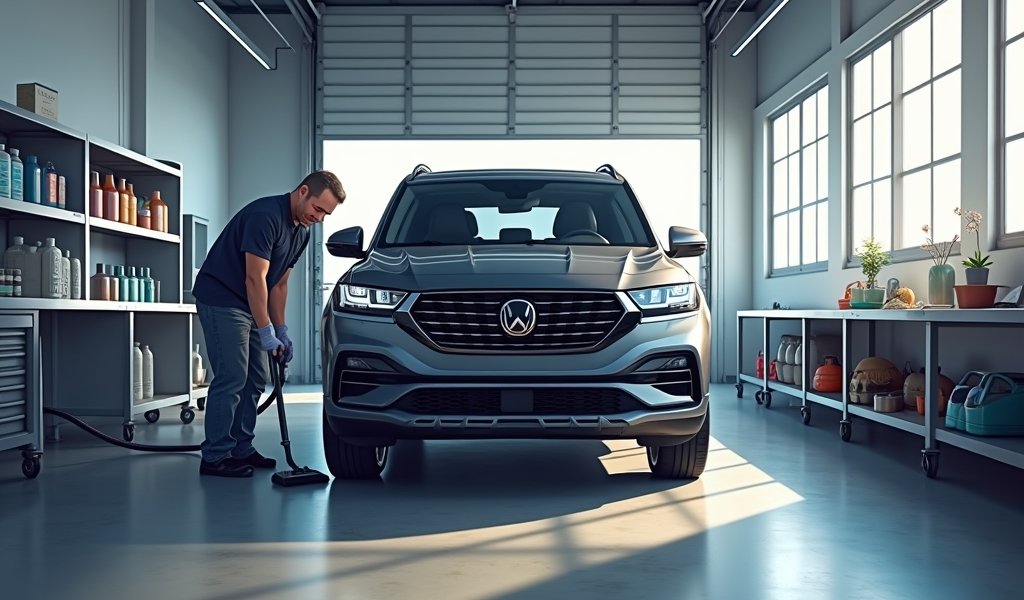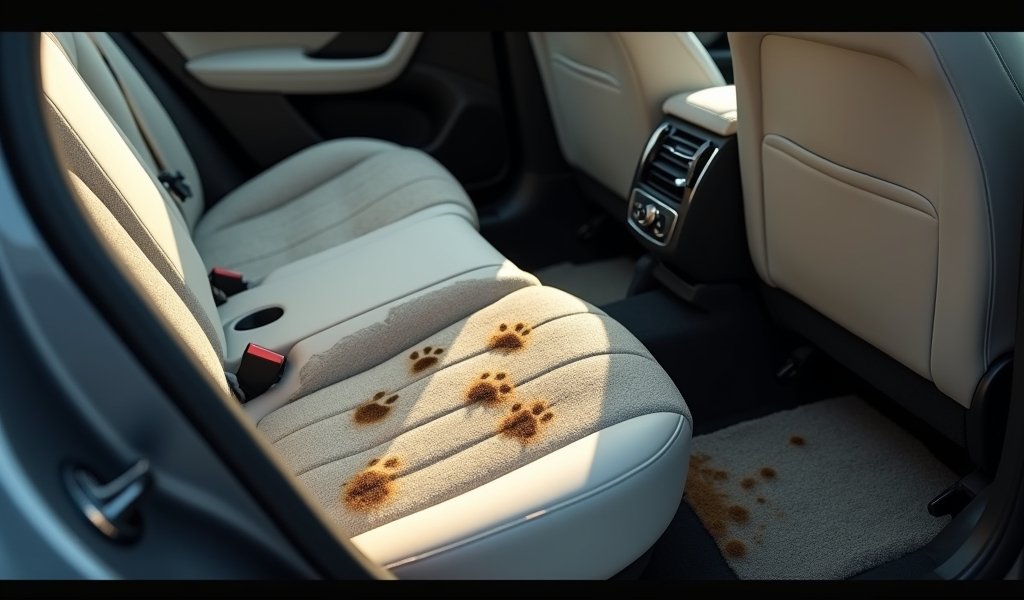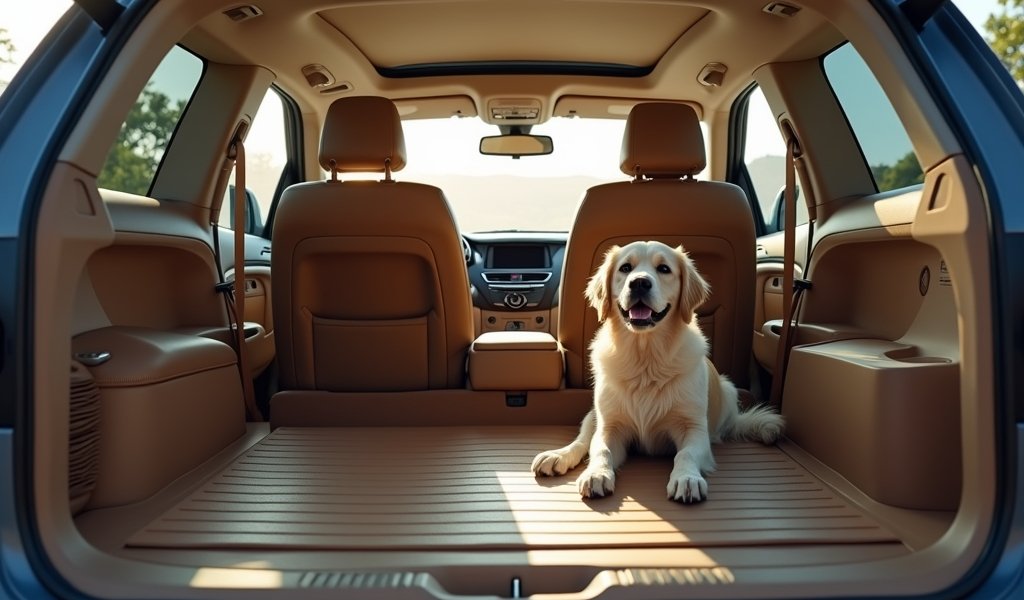Overview
This article provides detailed strategies for maintaining a clean and undamaged car interior while transporting pets, covering specialized seat covers, hair management, scratch protection, odor control, accident cleanup, and gear organization. It emphasizes that with proper preventative measures and regular maintenance, pet owners can protect their vehicle’s value while creating a comfortable environment for both human and animal passengers.
Table of Contents
- Keeping Your Car Pet-Friendly: Why Interior Care Matters
- The Challenges of Pet Ownership for Car Interiors
- Choosing the Right Seat Covers for Pet Transport
- Managing Pet Hair: Prevention and Cleanup Tips
- Protecting Your Interior Against Scratches and Claw Marks
- Odor Management Strategies for Pet-Friendly Vehicles
- Cleaning Up Accidents Quickly and Effectively
- Organizing Pet Gear for Minimal Interior Impact
- Conclusion
- Frequently Asked Questions
Keeping Your Car Pet-Friendly: Why Interior Care Matters
For those of us who consider our pets family members, pet friendly cars aren’t just a luxury—they’re a necessity. As an automotive technician who’s seen thousands of vehicles in various states of “pet wear,” I can tell you that maintaining your car’s interior while regularly transporting furry friends requires some specialized knowledge. Whether you’re taking daily trips to the dog park or embarking on cross-country adventures with your four-legged companion, proper interior care can extend your vehicle’s life and keep it looking (and smelling) its best.
Pets bring immeasurable joy to our lives, but they also bring fur, drool, muddy paws, and occasionally accidents that can take a toll on even the most resilient car interiors. The good news? With some preventative measures and regular maintenance, you can create a vehicle environment that welcomes both human and animal passengers without sacrificing cleanliness or comfort.
Throughout my 15 years working with vehicle interiors, I’ve developed practical strategies that strike the perfect balance between pet-friendly accommodation and vehicle preservation. These aren’t just theoretical tips—they’re road-tested solutions that have helped countless pet owners maintain their car’s value while keeping their companions comfortable and secure.
The Challenges of Pet Ownership for Car Interiors
Before diving into solutions, it’s worth understanding exactly what we’re up against when it comes to pets and vehicles. Dogs and cats present unique challenges that standard car care routines don’t adequately address. The most common issues I see in my shop include embedded pet hair that standard vacuums struggle to remove, claw marks on leather and vinyl surfaces, persistent odors that seem to defy air fresheners, and stains from accidents or wet fur.
Different vehicle interiors also respond differently to pet exposure. Cloth upholstery tends to trap hair and absorb odors more readily, while leather and vinyl can be more susceptible to scratch damage. Even your car’s carpet and floor mats face unique challenges, as they become collection points for dirt, hair, and debris tracked in on paws.
The frequency of pet transport matters too. Weekend warriors who occasionally take their dog to a hiking trail face different challenges than daily commuters whose pets join them for every errand. According to research from the American Veterinary Medical Association, approximately 85% of dog owners transport their pets in their vehicles at least once weekly, making interior protection a significant concern for millions of drivers.

Choosing the Right Seat Covers for Pet Transport
Your first line of defense in creating truly pet friendly cars is high-quality seat protection. Not all seat covers are created equal when it comes to pet transport, and investing in the right product can save you countless hours of cleaning and potential upholstery damage.
When selecting car seat covers for pets, look for these essential features:
- Waterproof or water-resistant material that prevents moisture from reaching your upholstery
- Durable, scratch-resistant fabrics that can withstand claws and general pet movement
- Non-slip backing that keeps the cover securely in place during travel
- Machine-washable design for easy maintenance
- Compatibility with your vehicle’s safety features, including seat belts and airbags
Hammock-style seat covers have become increasingly popular among pet owners, as they not only protect your seats but also create a barrier that prevents pets from accessing the floor area or front seats. These covers attach to the headrests of both front and back seats, creating a hammock-like enclosure that contains fur and dirt while giving your pet a secure space.
For larger vehicles or SUVs, consider cargo area liners specifically designed for pet transport. These typically extend up the back of the rear seats and include a bumper flap to protect your vehicle during loading and unloading. The right cargo liner can transform your SUV into a pet-friendly transport zone while preserving your interior’s condition.
Installation matters too. Even the best seat cover provides limited protection if improperly installed. Take time to secure all straps, ensure coverage extends to areas where your pet might place their paws, and regularly check that covers haven’t shifted during use. A properly installed seat cover system can provide years of protection with minimal maintenance required.
Managing Pet Hair: Prevention and Cleanup Tips
Pet hair might be the single most persistent challenge for vehicle interiors. It works its way into upholstery fibers, wedges between seats, and seems to multiply even after thorough cleaning. As a professional who’s tackled thousands of pet-hair-infested vehicles, I’ve found that a combination of prevention and specialized removal techniques yields the best results.
Prevention starts before your pet even enters the vehicle. A quick brushing session can dramatically reduce shedding during travel. For dogs especially, regular grooming removes loose fur that would otherwise end up embedded in your car’s upholstery. Consider keeping a designated pet brush in your vehicle for quick pre-trip grooming sessions.
For hair that inevitably makes its way into your vehicle, conventional vacuums often disappoint. Instead, try these professional techniques:
- Use rubber gloves or a dampened rubber pet hair removal brush to create static that lifts hair from upholstery
- For stubborn embedded hair, spray fabric surfaces lightly with water and use a squeegee to gather hair into removable clumps
- Velcro hair removal brushes work exceptionally well on carpet and floor mats
- For hard-to-reach areas between seats, wrap duct tape around your fingers (sticky side out) to pick up stray hairs
Investing in a portable vacuum specifically designed for pet hair can be a game-changer. Look for models with rubber nozzles or specialized pet hair attachments. These are engineered to loosen and lift hair that standard vacuums leave behind.
For those who transport pets frequently, consider purchasing quality pet car accessories like washable seat covers or specialized pet hair removal tools. These make regular maintenance significantly easier and more effective than struggling with standard cleaning tools not designed for pet hair removal.
Protecting Your Interior Against Scratches and Claw Marks
Scratch protection is critical for leather and vinyl interiors, which can be permanently damaged by excited pets. Even the most well-behaved animals may inadvertently mark your surfaces during travel, especially when startled or excited. In my years servicing vehicle interiors, I’ve seen how quickly a single incident can leave lasting damage.
Door panels are particularly vulnerable, as pets often paw at windows or brace themselves against doors during turns. Consider installing clear vinyl door guards or specialized pet shields that protect these surfaces while remaining nearly invisible. These products attach with automotive-safe adhesives and can be removed without damaging your interior.
For leather seats, the best protection is prevention through proper covers, but specialized leather conditioners can help resist claw marks and make cleaning easier. Apply these products quarterly to maintain leather’s natural resilience. Some newer conditioners include scratch-resistant properties specifically formulated for homes and vehicles with pets.
Training your pet to remain calm in the vehicle can significantly reduce scratch damage. Many animals scratch from anxiety or excitement, so acclimating them to car travel through short, positive trips can minimize this behavior. For dogs, ensuring they’re properly secured with a quality travel carrier or harness not only improves safety but reduces their ability to damage interior surfaces.

Odor Management Strategies for Pet-Friendly Vehicles
Even the cleanest pets can leave behind odors that become trapped in your vehicle’s upholstery and ventilation system. Standard air fresheners typically mask rather than eliminate these smells, leading to a confusing mixture of pet odor and artificial fragrance. As someone who’s rehabilitated countless “smelly” vehicles, I can tell you that effective odor management requires addressing the source rather than covering it up.
The foundation of odor control is regular cleaning with enzymatic cleaners specifically formulated for pet odors. These products contain beneficial bacteria that actually consume odor-causing organic matter rather than simply masking smells. Apply these cleaners according to manufacturer instructions, typically allowing adequate dwell time for the enzymes to work before wiping or vacuuming.
Don’t forget your vehicle’s ventilation system, which can harbor pet odors even when upholstery has been cleaned. Consider these professional strategies:
- Replace your cabin air filter more frequently when regularly transporting pets
- Use specialized HVAC cleaning treatments designed for automotive systems
- Set your climate control to “fresh air” mode occasionally rather than recirculation to prevent odors from becoming concentrated
- Treat air intake areas with enzyme sprays to eliminate odors at their source
For fabric surfaces, baking soda remains one of the most effective natural deodorizers. Sprinkle generously on seats, carpets, and floor mats, allow it to sit overnight, then vacuum thoroughly. The baking soda absorbs odors rather than masking them, leaving a genuinely neutral rather than artificially scented result.
According to a study from the American Kennel Club, regular deep cleaning of all soft surfaces is essential for maintaining an odor-free vehicle. This includes removing and washing fabric seat covers, treating carpets and headliners, and cleaning hard surfaces where oils from pet fur might accumulate.
Cleaning Up Accidents Quickly and Effectively
Even well-trained pets can have accidents in vehicles, especially during longer trips or stressful situations like veterinary visits. The key to preventing permanent damage is immediate and appropriate action. As a detailing professional, I’ve seen how the first few minutes after an accident can determine whether a simple cleanup or extensive restoration is required.
Keep an emergency cleaning kit in your vehicle that includes:
- Absorbent paper towels or microfiber cloths
- Enzyme-based pet stain and odor remover
- Clean water in a spray bottle
- Disposable gloves
- Sealed bag for containing soiled materials
For liquid accidents, blot—don’t rub—to remove as much moisture as possible. Rubbing drives the liquid deeper into upholstery fibers, making complete removal nearly impossible. After blotting, spray the area with an enzymatic cleaner and allow it to penetrate according to product instructions before blotting again.
For solid accidents, remove material carefully using gloves and disposable materials, then treat the area with enzymatic cleaner. Multiple applications may be necessary for complete odor elimination. Remember that heat sets protein-based stains, so avoid hot water or heat-based drying methods.
If an accident occurs and you can’t clean it immediately, at minimum blot up excess moisture and sprinkle baking soda on the area to absorb odors until proper cleaning can be performed. This temporary measure can prevent permanent staining and odor establishment.
For particularly severe accidents that have penetrated to the padding beneath upholstery, professional extraction with specialized equipment may be necessary. Most detailing shops offer this service, which uses high-powered extraction to remove contaminants from all layers of your vehicle’s interior.
Organizing Pet Gear for Minimal Interior Impact
Transporting pets often means bringing along their gear—toys, treats, water bowls, leashes, and waste bags. Without proper organization, these items can contribute to interior disorder and accelerated wear. Creating dedicated storage solutions within your vehicle can maintain order while protecting interior surfaces.
Consider installing a vehicle organizer specifically designed for pet supplies. These range from simple hanging bags that attach to seat backs to more elaborate systems with waterproof compartments for wet items and separate sections for different supplies. Keeping treats and toys contained reduces the chance of spills and prevents items from becoming projectiles during sudden stops.
Water is essential during travel but can create significant interior damage if spilled. Invest in spill-proof travel bowls or bottle adapters that minimize the risk of accidents. Keep these items in waterproof containers when not in use, especially if they’ve been used and might still be damp.
For muddy adventures, pack old towels in a waterproof bag to wipe down your pet before they re-enter the vehicle. A quick paw-cleaning can prevent mud and debris from transferring to your interior. Some pet owners keep a spray bottle of water and a dedicated “pet towel” in their vehicle for this purpose.
Storage solutions that hang from headrests or attach to seat backs maximize your available space while keeping essentials within reach. These organizers prevent pet supplies from sliding around on seats or floors, reducing cleaning needs and interior wear. Many are designed to be removable for cleaning or transfer between vehicles.
Conclusion
Creating truly pet friendly cars requires a combination of preventative measures, quick responses, and regular maintenance. The seven interior care tips we’ve explored—selecting appropriate seat covers, managing pet hair, preventing scratches, controlling odors, cleaning accidents promptly, and organizing pet gear—create a comprehensive system for maintaining your vehicle’s interior while accommodating your four-legged companions.
Remember that consistency is key. Implementing these strategies occasionally won’t deliver the same results as making them part of your regular vehicle maintenance routine. Small daily efforts, like quickly removing hair after each trip or immediately addressing minor messes, prevent the larger problems that require intensive restoration.
With these professional techniques, you can enjoy the companionship of your pets during travel without sacrificing your vehicle’s condition or value. Your car can be both a comfortable space for your animal companions and a clean, pleasant environment for human passengers. After all, the joy of having our pets accompany us on life’s journeys far outweighs the extra effort required to keep our vehicles in top condition.
By implementing these specialized interior care strategies, you’re not just protecting your investment—you’re creating a more enjoyable travel experience for everyone in your vehicle, whether they have two legs or four.
Frequently Asked Questions
How often should I vacuum my car if I regularly transport pets?
For regular pet transport, vacuum your car’s interior at least once weekly using a pet hair attachment. Increase frequency during heavy shedding seasons or after muddy outdoor activities.
What’s the best material for pet-friendly car seat covers?
Look for waterproof, tear-resistant materials like heavy-duty nylon, polyester with waterproof backing, or neoprene. The best covers combine water resistance with durability and have non-slip backing to stay securely in place.
Can leather seats be protected from pet claws?
Yes, leather seats can be protected using specialized seat covers or by applying leather conditioner with UV protection quarterly. For added protection, consider using a pet travel harness or carrier to restrict movement.
How do I remove embedded pet hair from car upholstery?
Use a rubber pet hair removal brush, pumice stone, or slightly dampened rubber gloves to create static that lifts embedded hair. For stubborn areas, lightly mist with water and use a squeegee to gather hair into removable clumps.
What’s the most effective way to eliminate pet odors from my car?
Use enzymatic cleaners specifically designed for pet odors on all fabric surfaces and replace your cabin air filter. Follow with an odor absorber like baking soda rather than masking smells with air fresheners.

